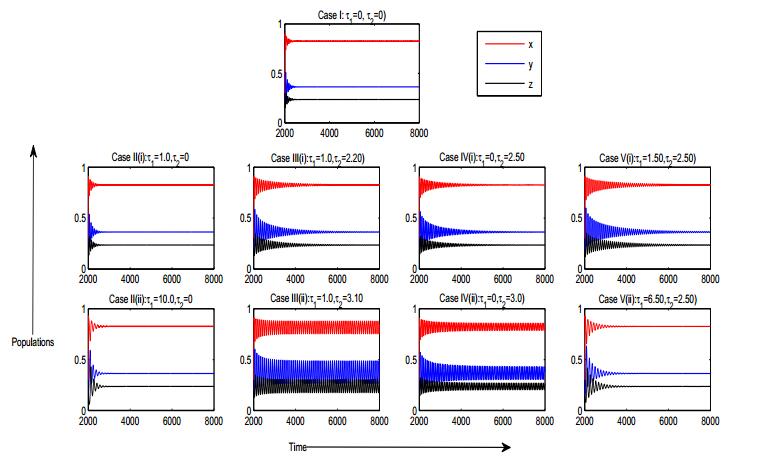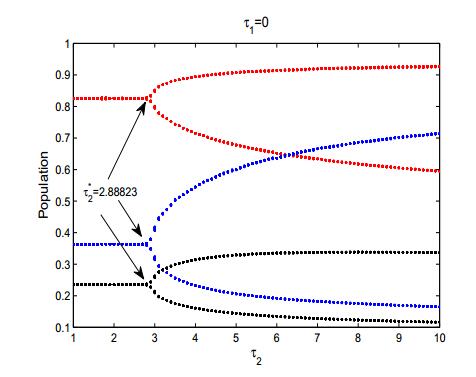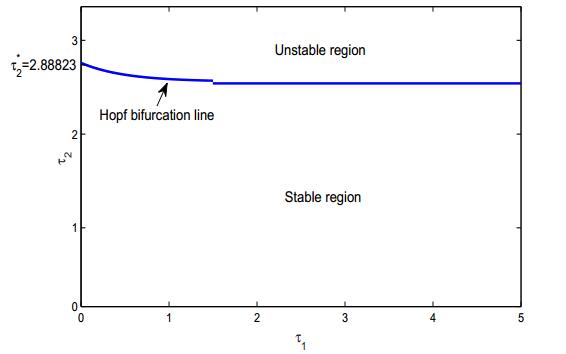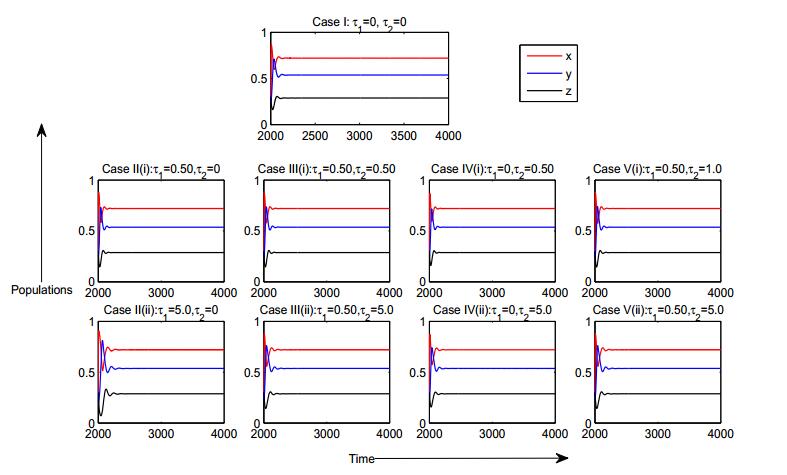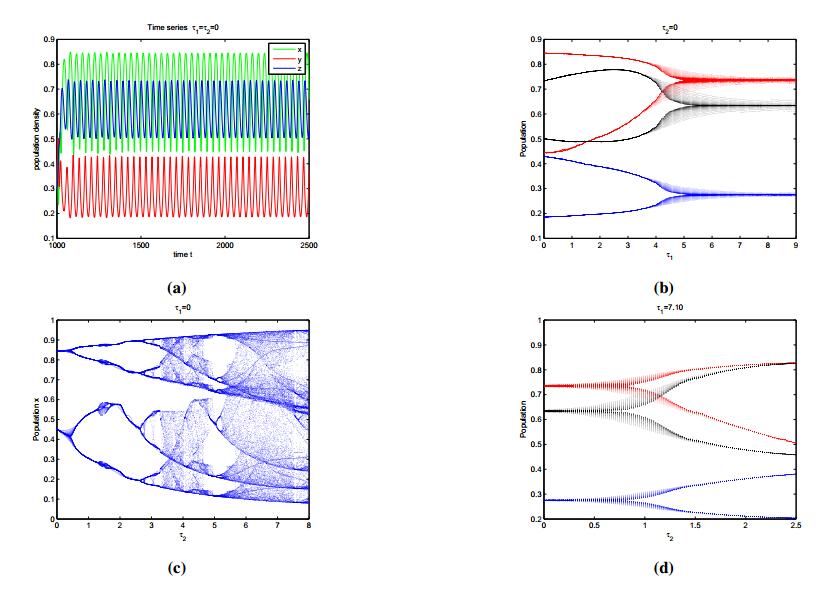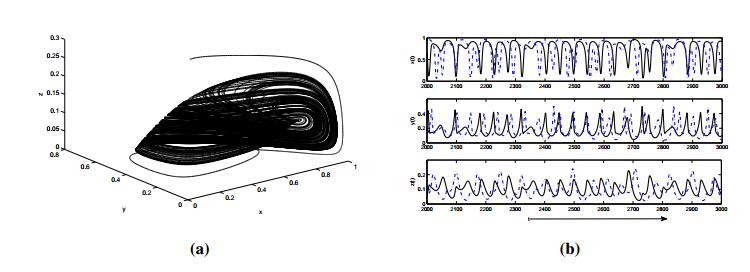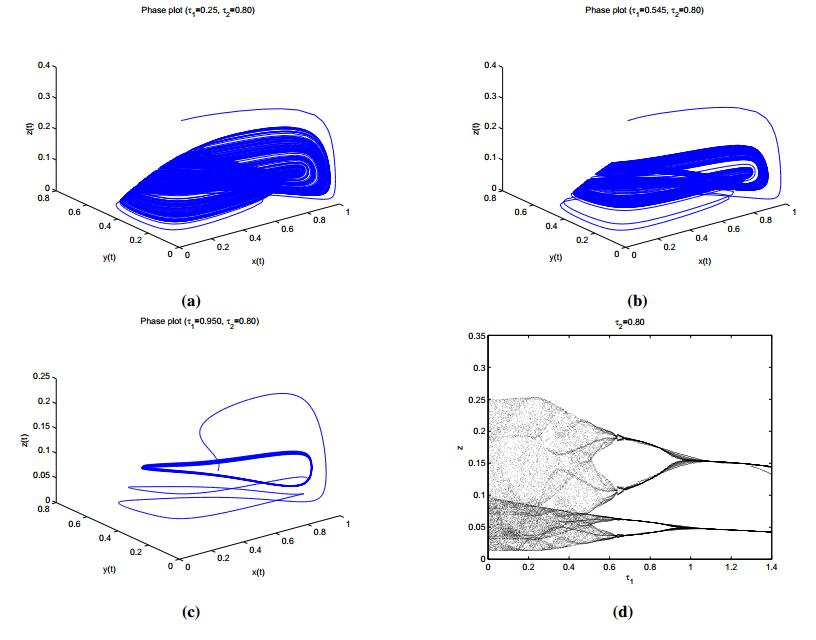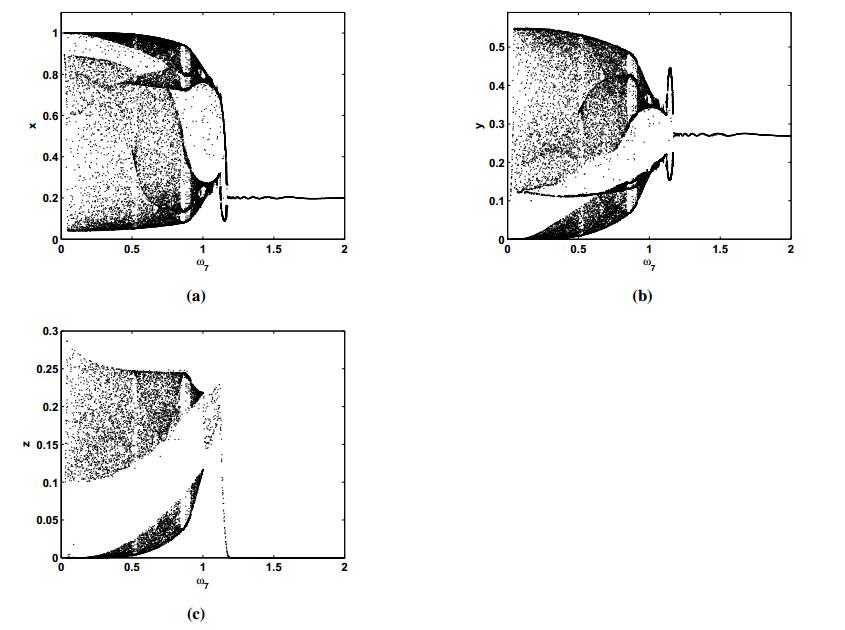This work is mainly focused on the series of dynamical analysis of tritrophic food chain model with Sokol-Howell functional response, incorporating the multiple gestation time delays for more realistic formulation. Basic properties of the proposed model are studied with the help of boundedness, stability analysis, and Hopf-bifurcation theory. By choosing the fixed parameter set and varying the value of time delay, the stability of the model has been studied. There is a critical value for delay parameter. Steady state is stable when the value of delay is less than the critical value and further increase the value of delay beyond the critical value makes the system oscillatory through Hopf-bifurcation. Whereas, another delay parameter has a stabilizing effect on the system dynamics. Chaotic dynamics has been explored in the model with the help of phase portrait and sensitivity on initial condition test. Numerical simulations are performed to validate the effectiveness of the derived theoretical results and to explore the various dynamical structures such as Hopf-bifurcation, periodic solutions and chaotic dynamics.
1.
Introduction
Time delays are ubiquitous in all biological situations, as species require some time in order to complete various biological activities such as digestion, gestation, maturation, incubation, etc. Also, the present growth of species may be affected by the past generations through delay mechanism [1,2]. Introduction of time delay may change qualitatively the dynamical behaviors of a predator-prey interaction model, therefore, it is important to investigate the dynamical properties of a predator-prey model with time delays in both theoretical research and practical applications. One of the interesting observation of inclusion of time delay is the appearance of oscillatory behaviour in single species models [3,4]. Time delay can produce chaotic oscillations even in simple predator-prey models [5,6]. The introduction of time delay leads to rich dynamical behaviors such as periodic orbits, stability switching, chaotic dynamics, and multiple stable coexistence through the different bifurcation routes [7]. Mathematical models incorporating the time delays are widely discussed in the books of MacDonald [8], Kuang [3] and Cushing [9].
Recently, the impact of multiple delays on the dynamics of ecological systems has caught the attention of many researchers. In particular, Gakkhar and Singh [5] have studied the predator-prey model with Holling type Ⅱ response function and discrete delays. They have observed that the stable species coexistence undergoes Hopf-bifurcation for the critical value of delay and a further increase in delay beyond the Hopf-bifurcation leads the system dynamics to the chaotic state. Also in two neuron system with multiple delays, Song et al. [10,11] have obtained stability switching, multiple stable coexistence of two resting states, two anti-symmetric periodic activity with period three, one self-symmetric periodic activity with period one, one quasiperiodic spiking and chaotic behavior. Jiang et al. [12] have considered the Phytoplankton-Zooplankton model with Holling Ⅲ functional response and discrete delay. They have shown that the oscillations can be prevented by adjusting the magnitude of delay. Song et al. [13] have discussed the food chain system with multiple digestion delays and predicted that the multiple delays can generate and suppress the higher order limit cycles and chaos. Lotka-Volterra food chain system with two discrete delays has been investigated by Cui and Yan [14]. They have determined the linear stability, Hopf-bifurcation, direction and stability of bifurcating period solutions by considering the sum of two delays as a bifurcating parameter. Jiang and Wang [15] have investigated the predator-prey model with three delays and discussed the delay induced destabilization and stability analysis of periodic solutions. Further, Ghosh et al. [16] have studied the stability and bifurcation analysis of an eco-epidemiology model with multiple delays. Three species Leslie-Gower type food chain model with resource digestion delay and consumer digestion delay is analyzed by Guo et al. [17]. It has been noted that the multiple delays lead to the stability switching, generate or terminate the recurrent bloom and help control the species population to the stable coexistence.
Delay induced destabilization is a common finding. A lot of work has been done with the objective to find the critical value of the delay parameter at which system bifurcates from its stable state and starts showing the oscillatory behaviour [18,19,20,21,22,23]. However, Sen et al. [24] have provided the necessary and sufficient conditions for stability of interior equilibria in a ratio-dependent predator-prey model with Allee effect and maturation delay. Stabilizing effect of maturation delay in a ratio-dependent predator-prey model with Allee effect is investigated by Banerjee and Takeuchi [25]. Wang and Jiang [26] have demonstrated that different values of delay can induce or eradicate chaotic dynamics in the predator-prey system with dormancy in predator. Motivated by these research work, we have asked the following research questions in the current manuscript:
(ⅰ) How do multiple gestation delays affect the stable and oscillatory coexistence of species? Do several delays behave in a similar fashion?
(ⅱ) Is it possible to obtain some parameter sets so that stable coexistence of species is not affected by the introduction of delays?
(ⅲ) Is it possible to obtain various complex dynamical behaviors such as higher order limit cycles and chaos? If yes, what is the impact of delays on these complex dynamical structures?
For ecological forecasting, it is necessary to understand the predator-prey linkage in food chain or web systems. Different functional and numerical responses are used for modeling the trophic interactions and they are one of the most important components in the study of interacting populations. In most of the studies, population dynamics is modeled with the help of monotonic response functions (Holling type Ⅰ, Ⅱ, Ⅲ). Observational and experimental results show that these types of response functions are not appropriate for modeling the situations with group defence and inhibitory effects [27]. More suitable in these situations is Holling type Ⅳ functional response [28,29]. In their experiment of uptake of phenol by pure culture of Pseudomonas putida growing on phenol in continuous culture, Sokol and Howell [30] proposed the simplified form of Monod-Haldane functional response as p(x)=mxa+x2. They obtained that fits better fits to the experimental data and simple as involving only two parameters. Edwards [31], Boon and Laudelout [32], Xiao and Ruan [27] suggested that this type of functional response takes place at the microbial level: when the nutrient concentration attains a high value, an inhibitory effect on the specific growth rate may occur. Recently, Ali et al. [33,34] proposed a three species food chain system with Sokol-Howell functional response. They have studied the boundedness, local and global stability of the system. Dynamical behavior is also explored by using the numerical simulations. Explosive instabilities in three species food chain model with this functional response have been investigated by Parshad et al. [35]. A three species Rosenzweig-MacArthur food chain model with this functional response has been investigated by Ali et al. [36].
In the current work, we have studied a food chain model with multiple gestation delays. As assimilation of prey into the predator biomass is a complex phenomenon and completed through various bio-physiological activities, which require time, therefore, time lags in predators gestation process have been considered. Effect of gestation delay in the system of interacting populations is studied by many researchers [18,19,20,22,23,37,38,39]. Patra et al. [40] have analyzed the effect of discrete delay in a three species food chain model with ratio-dependent type functional response. Pal et al. [41] have studied the tritrophic food chain model with gestation delay, where species interacts with Holling type II response function. Here, gestation delays are incorporated in the model using the Wangersky-Cunningham delay formulation [42]. The conventional way of delay formulation has been extensively studied in literature [5,24,40,43]. In recent years, Wangersky-Cunningham delay formulation is used prominently due to its clear biological explanation [19,24,25,41].
The organization of paper is as follows. Formulation of the model is given in section 2. In section 3, positive invariance, boundedness, equilibria and stability analysis have been discussed. Local stability analysis and Hopf-bifurcation about the interior equilibrium point for all possible cases to incorporate gestation delays have been derived in section 4. Numerical simulation results have been presented in section 5. Finally, discussion and conclusion are given in the last section.
2.
Formulation of the mathematical model
The model has been developed under the following assumptions.
(1) The behavior of whole community arises due to the coupling of three types of interacting populations: prey X(t), intermediate predator Y(t) and top predator Z(t).
(2) Prey population grows logistically with intrinsic growth rate r and carrying capacity K. Thus, per capita growth rate of prey in the absence of predator is given by r(1−X(t)K).
(3) Intermediate and top predators consume their sole food (prey and intermediate predator respectively) according to Sokol-Howell functional response.
(4) In the absence of their only foods intermediate and top predators die out with their natural death rates.
(5) Consumption of prey by the predator is not an instantaneous process. However, predator requires some period of time to convert the prey density into itself due to gestation.
Under the above assumptions, interactions between the species are modeled by the following system of DDEs:
All the parameters r,K,ω,a1,b,ω1, ω2,a2,c,ω3,T1 and T2 are positive and brief description about these parameters is given in Table 1.
Model (2.1) involves 12 parameters, which complicates the system analysis. Thus, to reduce the complexity of model (2.1), we non-dimensionalize it by using the following transformations:
Then model (2.1) is reduced in the following dimensionless form:
All the variables and parameters of dimensionless system (2.2) are positive. We denote by C the Banach space of continues functions ϕ:[−τ,0]→R3 with norm
The initial conditions are given as
For biological reasons, it is assumed that
By the fundamental theorem of differential equations [44], there exists a unique solution (x(t),y(t),z(t)) of the model (2.2) with initial conditions (2.3).
3.
Preliminaries
In this section, we present some basic results such as positive invariance, boundedness of the solutions, equilibria analysis and characteristic equation of model (2.2).
3.1. Positive invariance
It is important to discuss the positivity of solutions of model (2.2) as they represent the populations of prey, intermediate predator and top predator at any time. In the biological sense, positivity makes sure that population never becomes negative and always survives in the finite time. We have established the positivity through the following theorem.
Theorem 3.1. Every solution of the system (2.2) with initial conditions (2.3) is positive.
Proof. The model (2.2) with the initial conditions (2.3) can be written in the following form:
The model (2.2) becomes
with W(θ)=(ϕ1(θ),ϕ2(θ),ϕ3(θ))∈C+andϕ1(0),ϕ2(0),ϕ3(0)>0. It is easy to check in system (3.2) that whenever choosing W(θ)∈R3+ such that x=y=z=0, then
with w1(t)=x(t),w2(t)=y(t),w3(t)=z(t). Using the lemma 4 given in [45], any solution of (3.2) with W(θ)∈C+ saying W(t)=W(t,W(θ)), is such that W(t)∈R3+ for all t≥0. Hence the solution of the system (3.2) exists in the region R3+ and all solutions remain nonnegative for all t>0. Therefore, the positive orthant R3+ is an invariant region.
3.2. Boundedness
Theorem 3.2. Let (x(t),y(t),z(t)) be any positive solution of the model (2.2), then there exists a time ˜T>0, such that 0≤x(t)≤M1,0≤y(t)≤M2 and 0≤z(t)≤M3 for t>˜T, where M1=1,M2 = ω64ω5,M3=ω6ω9(ω5−δ)4ω5δ, δ is any positive constant satisfying δ<min{ω5,ω8}.
Proof. From the positive invariance theorem, we have x(t)≥0, y(t)≥0 and z(t)≥0. Therefore, we only need to show that x(t)≤M1,y(t)≤M2 and z(t)≤M3. From the prey equation, we obtain that
thus
therefore,
Now, we construct a new function
By differentiating σ(t) with respect to time t, we obtain
And by using the positivity of solutions, we get
Then adding ω5σ(t) on the both side of above inequality, we get
Since, max{x(t−τ1)(1−x(t−τ1))}=14, implies,
Therefore, by using the lemma (2) given in [46], we obtain
If ˜T1=0, then
therefore
i.e.
thus,
Again for boundedness of z(t), we construct another function
By differentiating above equation with respect to time t, we have
Now, by using system (2.2), we obtain
And by adding δγ(t) on the both side of above inequality, where δ<min{ω5,ω8}, we obtain
Then using the boundedness of x(t), we obtain
Therefore, from lemma 2 given in [46], we have
If ~T2=0, then,
Therefore
where
Thus
3.3. Equilibria analysis
Steady state solutions are obtained analytically by putting ˙x=0,˙y=0 and ˙z=0, which are independent of time delays τ1 and τ2. The model has four equilibrium points.
(ⅰ) Trivial equilibrium point P0(0,0,0) always exists.
(ⅱ) Predators free axial equilibrium point P1(1,0,0) exists.
(ⅲ) Top predator free planar equilibrium point P2(ˉx,ˉy,0), where ˉy=(1−ˉx)(ˉx2+ω4), and ˉx is a solution of the equation
which has positive solution ˉx if
Notice that ˉy>0 iff ˉx<1.
Following we discuss the existence conditions of P2 for three cases.
(a)
(b)
(c)
(ⅳ) Positive coexistence equilibrium point P3(x∗,y∗,z∗) exists provided
where y∗=ω9±√ω29−4ω28ω72ω8, z∗=(y∗2+ω7)(−ω5+ω6x∗x∗2+ω4), and x∗ is the positive root of following equation
Let f(x∗)=x∗3−x∗2+ω4x∗+y∗−ω4, then f(0)=(y∗−ω4), f(0)<0 if y∗<ω4, i.e. ω4ω9<ω8(ω7+ω24) and f(1)=y∗>0. Since f(0)f(1)<0, by intermediate value theorem, Eq. (3.6) has a positive root lies in (0, 1) when
Positive equilibrium point P3(x∗,y∗,z∗) exists if the conditions (3.5) and (3.7) hold.
In the absence of both delays, the general variational matrix of model (2.2) at any arbitrary point (x,y,z) is given by
The behaviour of equilibrium points is summarized as follows.
(ⅰ) Eigenvalues of variational matrix at P0(0,0,0) are 1,−ω5,−ω8. Therefore, P0 is a saddle point having unstable manifold along x-direction and stable manifold along y and z-direction.
(ⅱ) Eigenvalues of variational matrix at P1(1,0,0) are −1,−ω5+ω61+ω4,−ω8. Therefore, P1 is locally asymptotically stable (LAS) provided ω61+ω4<ω5.
(ⅲ) At P2(ˉx,ˉy,0), the variational matrix becomes
A is stable iff
Define f(x)=ω5x2−ω6x+ω4ω5. Then we have f(ˉx)=0, and
Since f(√ω4)=2ω4ω5−ω6√ω4≤0, we have ˉx−<√ω4<ˉx+. Hence by (3.9), P+2=(ˉx+,ˉy+,0) is always unstable. From (3.10), we have ω8ˉy2−ω9ˉy+ω7ω8>0. Hence ˉy>0 if ω29<4ω7ω28. That is, (3.10) is satisfied if there exists no P3(x∗,y∗,z∗).
Now let's consider the case where no P3 exists. For this case, (3.10) is satisfied for any ˉy>0 and (3.9) is satisfied for ˉx−. Since ˉy−=(1−ˉx−)(ˉx2−+ω4), we have
(a) When ω4>1/3, (3.12) is satisfied for any ˉx−≥0. Hence, P−2 is LAS when ω4>1/3 and no P3 exists.
(b) When ω4<1/3,
where ˉx−=ω6−√ω26−4ω4ω252ω5.
Hence P−2 is LAS when ω4<1/3 and no P3 exists and (3.13) is satisfied.
4.
Local stability analysis and Hopf-bifurcation
In this section, we discuss the effect of discrete delays on the dynamics of model (2.2).
At P0, characteristic equation is
There are one positive root λ1=1 and two negative roots λ2=−ω5,λ3=−ω8, which are independent of τ1 and τ2. Hence P0 is unstable for any τ1≥0 and τ2≥0.
At P1, characteristic equation is
There are one root λ1=−ω5+ω61+ω4e−λτ1 and two negative roots λ2=−1,λ3=−ω8.
Following we consider the equation
If τ1=0, then λ1=−ω5+ω61+ω4. It shows that P1 is LAS when ω61+ω4<ω5. If τ1>0, let us suppose that λ1=iω(ω>0) is a pure imaginary root of equation (4.1). Separating the real and imaginary parts, we have
Squaring and adding both sides of above equations lead to the following equation
This shows that P1 is LAS for any τ1,τ2≥0 if ω61+ω4<ω5.
If ω61+ω4>ω5, then equation (4.3) has one positive root ω−1=√(ω6+ω5(1+ω4))(ω6−ω5(1+ω4))1+ω4.
Solving equation (4.2) for τ1 yields
The minimum value of τ(j)1 is renamed as
Then, we have the following theorem.
Theorem 4.1. (ⅰ) P0 is unstable for any τ1≥0 and τ2≥0.
(ⅱ) P1 is LAS for any τ1,τ2≥0 if ω61+ω4<ω5.
(ⅲ) P1 is LAS for 0≤τ1<τ−1 and any τ2≥0 if ω61+ω4>ω5, where τ−1 is given by (4.5). Furthermore, model (2.2) undergoes Hopf-bifurcation to periodic solutions at P1 when τ1=τ−1.
For P2, we consider two cases.
Case a: τ1>0,τ2=0.
At P2, characteristic equation is
where
One characteristic root is λ1=−ω8+ω9ˉyˉy2+ω7. It is easy to show that λ1<0 for any τ1≥0 and τ2≥0 if and only if ω9ˉyˉy2+ω7<ω8.
Following we consider the equation
Let iω(ω>0) be a root of equation (4.7), then we have
Simplifying and equating real and imaginary part of equation (4.8), we get
Squaring and adding equations (4.9) and (4.10) we get
where
We define
G0(0)=q0=(e11+d22)2−(e11e22−e12e21)2, G1(∞)=∞.
Let
then G0(0)<0 and G0(∞)=∞. Thus, equation (4.31) has at least one positive root. Without loss of generality, we assume that it has finite number of positive roots saying ω1,ω2,ω3,⋯,ωN. For every fixed ωk,k=1,2,3,⋯,N, there exist a sequence {τk,j10∣j=0,1,2,⋯}, where
Let
Case b: τ1=0,τ2>0.
At P2, characteristic equation is
where h1=ˉy(ω4−ˉx2)(ˉx2+ω4)2+2ˉx−1>0 if the condition (3.8) is satisfied, h2=ˉxˉx2+ω4ω6(1−ˉx)(ω4−ˉx2)ˉx2+ω4>0 if the condition (3.9) is satisfied. Hence the equation λ2+h1λ+h2=0 have two negative roots if and only if the conditions (3.8) and (3.9) are satisfied. Following we consider the equation
Following a similar analysis of P1, we obtain the critical value
where ω−2=√(ω9ˉy+ω8(ˉy2+ω7))(ω9ˉy−ω8(ˉy2+ω7))ˉy2+ω7. The minimum value of τ(j)2 is renamed as
Then, we have the following theorem.
Theorem 4.2. (ⅰ) Suppose that τ1>0,τ2=0 and ω9ˉyˉy2+ω7<ω8 are satisfied. Then P2(ˉx,ˉy,0) is LAS for τ1<τ∗10 and unstable for τ1>τ∗10. Further, the system (2.2) undergoes the Hopf-bifurcation about P2 when τ1=τ∗10.
(ⅱ) Suppose that τ1=0,τ2>0, the conditions (3.8) and (3.9) are satisfied. Then P2(ˉx,ˉy,0) is LAS for any τ2>0 if ω9ˉyˉy2+ω7<ω8. And P2(ˉx,ˉy,0) is LAS for τ2<τ−2 if ω9ˉyˉy2+ω7>ω8, where τ−2 is given by (4.19). Furthermore, model (2.2) undergoes Hopf-bifurcation to periodic solutions at P2 when τ2=τ−2.
Next we obtain the characteristic equation of model (2.2) about interior equilibrium point P3(x∗,y∗,z∗) by linearizing the model (2.2). Let ˉx(t)=x(t)−x∗,ˉy(t)=y(t)−y∗,ˉz(t)=z(t)−z∗ be the perturbed variables about P3(x∗,y∗,z∗). Then the linearized form of model (2.2) is given by (bar signed are dropped for simplicity)
where
and \alpha = x^*{^2}+\omega_4, \; \beta = y^*{^2}+\omega_7 .
Thus, the characteristic equation of the linearized system is given by
where I_3 is an identity matrix of order 3.
Furthermore, equation (4.20) can be rewritten as the simplified form,
where
Now we discuss the following cases.
Case Ⅰ: \tau_1 = 0 = \tau_2 .
In this case, equation (4.21) becomes
where F_{12} = B_2+C_2+D_2, \; F_{11} = B_1+C_1+D_1+E_1, \; F_{10} = B_0+C_0+D_0+E_0 . Therefore, by Routh-Hurwitz criterion, P_3 = (x^*, y^*, z^*) is LAS in the absence of delay if
Straight forward calculation shows that F_{12} > 0 , if
F_{10} > 0 , if
(F_{12}F_{11}-F_{10}) > 0, \; if
and
Based on the above analysis, we have constructed the following theorem for stability of model (2.2) about E^*(x^*, y^*, z^*) in the absence of delay.
Theorem 4.3. Suppose that the interior equilibrium point P_3(x^*, y^*, z^*) exists. Then, P_3 is LAS provided the conditions (4.23)–(4.26) hold.
Case Ⅱ: \tau_1 > 0, \; \tau_2 = 0 .
In this case, equation (4.21) becomes
Let i\omega\; (\omega > 0) be a root of equation (4.27), then we have
Simplifying and equating real and imaginary part of equation (4.28), we get
Squaring and adding equations (4.29) and (4.30) we get
where
We define
Then G_1(0) = r_1 = (B_0+D_0)^2-(C_0+E_0)^2 , G_1(\infty) = \infty .
Let
then G_1(0) < 0 and G_1(\infty) = \infty . Thus, equation (4.31) has at least one positive root. Without loss of generality, we assume that it has finite number of positive roots saying \omega_1, \; \omega_2, \; \omega_3, \cdots, \omega_N . For every fixed \omega_k, \; k = 1, \; 2, \; 3, \cdots, N , there exist a sequence \{\tau_{1}^{k, j}\mid \; j = 0, 1, 2, \cdots\} , where
Let
By differentiating the equation (4.27) with respect to \tau_{1} , we have the following transversality condition
provided L_1(\omega_k)S_1(\omega_k)+R_1(\omega_k)T_1(\omega_k) > 0 , where
Then, we have the following theorem.
Theorem 4.4. Suppose that \tau_1 > 0, \; \tau_2 = 0 and conditions (4.23)–(4.26) are satisfied. Then the interior equilibrium point P_3(x^*, y^*, z^*) is LAS for \tau_1 < \tau^*_{1} and unstable for \tau_1 > \tau^*_{1} . Further, the system (2.2) undergoes the Hopf-bifurcation about P_3(x^*, y^*, z^*) when \tau_1 = \tau^*_{1} .
Case Ⅲ: \tau_{1}\in(0, \; \tau^*_{1}), \; \; \tau_{2} > 0 .
In this case, we assume that \tau_1 is arbitrarily fixed within the stable interval (0, \tau_1^*) , while consider \tau_2 as free parameter. Let i\omega ( \omega > 0 ) be a root of equation (4.21), then we have
Simplifying and equating real and imaginary part, we obtain
Squaring and adding above equations (4.37) and (4.38), we obtain
where
Following the same analysis as in Case Ⅱ, equation (4.39) has finite number of positive roots, saying \omega_1, \omega_2, \omega_3, \cdots, \omega_N , when
For every fixed \omega_k, \; k = 1, \; 2, \; 3, \cdots, N , there exist a sequence \{\widetilde{\tau}_{2}^{k, j}\mid \; j = 0, 1, 2, \cdots\} , where
where
Let
And assuming that
Then, we have the following theorem.
Theorem 4.5. Suppose that conditions (4.23)–(4.26) are satisfied and \tau_{1}\in(0, \; \tau^*_{1}) . Then the coexisting equilibrium point P_3(x^*, y^*, z^*) is LAS when \tau_2 < \widetilde{\tau}_{2}^* and it is unstable when \tau_{2} > \widetilde{\tau}_{2}^* . Moreover, Hopf-bifurcation occurs when \tau_{2} = \widetilde{\tau}_{2}^*.
Case Ⅳ: \tau_1 = 0, \; \tau_2 > 0 .
From the equation (4.21), we have
Let i\omega\; (\omega > 0) be a root of equation (4.44), then we have
Equating real and imaginary part of equation (4.45), we obtain
Squaring and adding both equations of system (4.46), we obtain
where
Now, similarly as in the Case Ⅱ, we define
G_2(0) = r_2 = (B_0+C_0)^2-(D_0+E_0)^2\; and \; G_{2}(\infty) = \infty .
Let
Then G_2(0) < 0 and G_2(\infty) > 0 , thus equation (4.47) has atleast one positive root. Without loss of generality, we have assume that it has finite number of positive roots say \omega_1, \omega_2, \omega_3, \cdots, \omega_N . For every \omega_k, \; k = 1, 2, 3, \cdots, N , there exists a sequence \{\tau_{2}^{k, j}\mid \; j = 0, 1, 2, \cdots\} , where
Let
Differentiating the equation (4.44) with respect to \tau_2 , we have the following transversality condition
provided L_2(\omega_k)S_2(\omega_k)+R_2(\omega_k)T_2(\omega_k) > 0 , where
Then, we have the following theorem.
Theorem 4.6. Suppose that \tau_1 = 0, \tau_2 > 0 and conditions (4.23)–(4.26) are satisfied. Then the equilibrium point P_3 is LAS for \tau_2 < \tau_2^* and unstable for \tau_2 > \tau_2^* . Further, the system (2.2) undergoes the Hopf-bifurcation around P_3(x^*, y^*, z^*) when \tau_2 = \tau_2^* .
Case Ⅴ: \tau_2\in(0, \; \tau_2^*) , \tau_1 > 0 .
In this case, we fix \tau_2 at some value from its stability range (0, \; \tau_2^*) and choose \tau_1 as free parameter, by the similar procedure used in Case Ⅲ. Stability results are summarized in the following theorem.
Theorem 4.7. Suppose that the parameters of model (2.2) are such that conditions (4.23)- (4.26) are satisfied, \tau_{2}\in(0, \; \tau_2^*) and condition (B_0+D_0)^2 < (E_0+C_0)^2 also holds. Then the coexisting equilibrium point P_3 is LAS, when \tau_1 \in (0, \; \widetilde{\tau}_1^*) and it is unstable when \tau_1 > \widetilde{\tau}_1^* . Moreover, Hopf-bifurcation occurs when \tau_1 = \widetilde{\tau}_1^*, where
with
and where
5.
Numerical experiment results
In this section, analytical findings and the various dynamics of model (2.2) have been illustrated with the help of numerical examples. In the following, we present three examples corresponding to stable positive equilibrium, limit cycles and chaos of the non-delay model, and we show how time delays influence the non-delay model.
Example 1. Taking \omega_4 = 1.4, \; \; \omega_5 = 0.22, \; \; \omega_6 = 0.8, \; \; \omega_7 = 2.29, \; \; \omega_8 = 0.09, \; \; \omega_9 = 0.6 in the model (2.2), yields the following system:
Initial densities of species are taken as (x_0, y_0, z_0) = (0.3, 0.3, 0.3) . Simulations are carried out in the non-delay system by Matlab. Unique positive interior equilibrium point is obtained as P_3 = (0.825453, 0.363298, 0.235593) . Here we have taken all numerical numbers with 6 digits after decimal to unify the results obtained from Mathematica.
Now, for system (5.1) we have verified all five cases with the help of numerical simulations.
(ⅰ) Case Ⅰ ( \tau_1 = \tau_2 = 0 ): F_{12} = 0.700569 > 0, \; F_{10} = 0.005547 > 0 and F_{12}F_{11}-F_{10} = 0.008031 > 0 . Thus, all the conditions of Case Ⅰ are satisfied. Numerical simulation results show that the interior equilibrium point, P_3 = (0.825453, 0.363298, 0.235593) is LAS (see Figure 1 (Case Ⅰ: \tau_1 = \tau_2 = 0 )).
(ⅱ) Case Ⅱ ( \tau_1 > 0, \tau_2 = 0 ): Conditional stability condition (4.33) is not satisfied, as (B_0+D_0)^2-(C_0+E_0)^2 = 0.000031 > 0 . We have not obtained any positive root of equation (4.31). Thus, we are not able to find any value of \tau_1 , where system experiences Hopf-bifurcation. System is LAS for all \tau_1 > 0 (see Figure 1 (Case Ⅱ(ⅰ): \tau_1 = 1.0, \; \tau_2 = 0 and Case Ⅱ(ⅱ): \tau_1 = 10.0, \; \tau_2 = 0 )).
(Ⅲ) Case Ⅲ ( \tau_1 \in (0, \tau_1^*), \tau_2 > 0 ): As in Case Ⅱ, system not bifurcates for any value of \tau_1 , thus all values of \tau_1 comes in its stability range. (B_0+C_0)^2-(E_0+D_0)^2 = -0.000019 < 0 , so conditional stability condition (4.40) is satisfied. In particular, we have taken \tau_1 = 1.0 , for this value of \tau_1 , \omega = 0.069338 and critical value of \tau_2 is obtained as \widetilde{\tau_2}^* = 3.0405 . System is LAS for \tau_2 = 2.2 < \widetilde{\tau_2} = 3.0405 and unstable for \tau_2 = 3.1 > \widetilde{\tau_2}^* = 3.0404 . Hopf-bifurcation occurs at \widetilde{\tau_2}^* = 3.0404 (see Figure 1 (Case Ⅲ(ⅰ): \tau_1 = 1.0, \; \tau_2 = 2.20 and Case Ⅲ(ⅱ): \tau_1 = 1.0, \; \tau_2^* = 3.10 )).
(ⅳ) Case Ⅳ ( \tau_1 = 0, \tau_2 > 0 ): (B_0+C_0)^2-(D_0+E_0)^2 = -0.000019 < 0 , thus conditional stability condition (4.48) is satisfied. Critical value of \tau_2 for \omega = 0.0794052 is obtained as \tau_2^* = 2.88823 .
thus transversality condition is also satisfied at \tau_2^* = 2.88823 . System is LAS for \tau_2 = 2.5 < \tau_2^* = 2.88823 and shows oscillations for \tau_2 = 3.0 > \tau_2^* = 2.88823 (see Figure 1 (Case Ⅳ(ⅰ): \tau_1 = 0, \tau_2 = 2.50 and Case Ⅳ(ⅱ): \tau_1 = 0, \tau_2 = 3.0 )). Hopf-bifurcation occurs at critical value of \tau_2 = \tau_2^* = 2.88823 .
(ⅴ) Case Ⅴ ( \tau_1 > 0, \tau_2 \in (0, \tau_2^*) ): In this case, for \tau_2 = 2.5 from its stability range (0, \; 2.88823) , conditional stability condition is not satisfied as (B_0+D_0)^2-(E_0+C_0)^2 = 0.000031 > 0 . Also we have not get any critical value of \tau_1 , in the stability range of \tau_2 . Thus, system not bifurcates for any value of \tau_1 in the stability range of \tau_2 . System is LAS for all \tau_1\geq 0 , \tau_2 \in (0, 2.88823) (see Figure 1 Case Ⅴ(ⅰ): \tau_1 = 1.50, \tau_2 = 2.50 , V(ⅱ) \tau_1 = 6.50, \tau_2 = 2.50 ).
Bifurcation diagram with respect to \tau_2 keeping \tau_1 = 0 is shown in Figure 2. This illustrates that the bifurcation occurs at critical value of \tau_2^* = 2.88823 , and below this value system (5.1) is stable and above this value system (5.1) shows oscillatory behaviour.
The two dimensional bifurcation diagram for the system (5.1) in \tau_1-\tau_2 plane has been presented in Figure 3. In this figure, the blue line denotes Hopf-bifurcation line i.e., at any point (\tau_1, \tau_2) on this blue line, system experiences Hopf-bifurcation. The regions which lie below and above this line are stability and instability regions, respectively. For \tau_2 < \tau_2^* = 2.88823 , system (5.1) remains stable for all \tau_1\geq 0 and for \tau_2 > \tau_2^* = 2.88823 , system (5.1) becomes unstable for all values of \tau_1\geq 0 . Here, we have only one critical value \tau_2^* , below which the system is stable and above which system becomes unstable and it remains unstable, thus the system does not exhibit stability switching [47] with further increase in values of delay parameters.
Further, in the numerical Example 1, we have taken \omega_7 = 3.29 , i.e. slightly increase the value of \omega_7 (protection provided by environment to the middle predator). Coexistence equilibrium point is obtained as P_3 = (0.720293, 0.536708, 0.287340) . Then, in the absence of delay, system in Example 1 is LAS (see Figure 4 (Case Ⅰ)). We have numerically discussed all the Cases (Ⅱ-Ⅴ) for different values of \tau_1 , \tau_2 and observed that system remains stable (see Figure 4 (Case Ⅱ-Ⅴ)). Thus, for sufficiently high value of environmental protection to the intermediate predator, system remains stable around coexistence equilibrium point and not bifurcates for any value of \tau_1 \; \text{and} \; \tau_2 (gestation delays for middle and top predators respectively). Detail description of all the Cases (I-V) is given in Table 2.
Example 2. Consider the following model with a new parameter set
Note that parameter values of system (4.6) are the same as those of system (5.1), except for \omega_4 and \omega_7 . That is, the protection provided by the environment to the prey and intermediate predator is decreased in Example 2. Dynamics of the original system (2.2) have been explored with the help of Example 2. It is observed that system (4.6) shows the limit cycle behaviour in the absence of delay (see Figure 5(a)). Now, we have investigated the effect of both delays \tau_1 and \tau_2 individually on the dynamics of system (4.6). It is clear from the Figure 5(b), when \tau_1 crosses the value {\tau}^{*}_{1} = 4.85 for \tau_2 = 0 , system (4.6) becomes stable and remains stable for \tau_1 > {\tau}^{*}_{1} = 4.85 , \tau_2 = 0 . Thus, oscillatory behaviour of coexisting equilibrium point is settled down to the stable dynamics. Again, effect of delay \tau_2 for \tau_1 = 0 , is determined by the Figure 5(c), which shows that increasing value of \tau_2 makes the system dynamics chaotic through the period doubling sequences. The combined effect of both the gestation delay \tau_1 and \tau_2 on the system dynamics is given in the Figure 5(d). Figure 5(d) is plotted at \tau_1 = 7.1 (value of \tau_1 at which system (4.6) is stable in the absence of \tau_2 ) while taking \tau_2 as bifurcating parameter. It is observed that the stable coexistence of species is lost by increasing the value of \tau_2 and oscillatory coexistence is obtained for higher value of \tau_2 .
Example 3. Again, consider the following example with new set of parameter values
Chaotic behaviour of model (2.2) is illustrated with the help of Example 3. To determine the chaotic behaviour of system, we have plotted the 3D phase portrait of the system. A chaotic attractor is obtained around which system tends to evolve for wide variety of initial conditions and for given sufficient time (see Figure 6(a)). Sensitivity on initial condition (SIC) test is one of the most intuitive tool to check the chaotic behaviour. SIC test tells that if the trajectories owning the slightly different initial conditions grow until their differences become as large as the signal then this ensures the existence of chaotic dynamics in the system. SIC test is given by Figure 6(b).
To describe the effect of gestation delay \tau_1 and \tau_2 on the chaotic dynamics of system, bifurcation diagram for x as a function of \tau_1 keeping \tau_2 = 0.8 is given by Figure 7(d), which shows that the period halving Hopf-bifurcation phenomenon. Therefore, increase in the value of \tau_1 leads to the stable limit cycle dynamics through sequence of chaotic dynamics and different order limit cycles (see Figure 7(a)–(c)).
Bifurcation diagrams of the species x, \; y, \; z are also presented taking \omega_7 as bifurcating parameter for system (5.4) in the absence of delay. Period halving Hopf-bifurcation phenomenon is observed. It is clear from the bifurcation figure that, for higher value of \omega_7 , i.e., protection provided by environment to the intermediate predator, species x, y will survive and remain stable, moreover species z will extinct (see Figure 8).
6.
Discussion and Conclusion
Empirical results supporting the existence of chaos in real ecological systems are very rare. McCann et al. [48] suggested that it might be due to weak links of species, which may provide stability to these systems. In addition, it is difficult to obtain the accurate data on intrinsic role of species interactions due to measurement error, weather fluctuation, and seasonal disturbances. Experimental demonstrations of chaos in a three species food chain system of ciliate Tetrahymena pyriformis, rod-shaped Pedobacter and coccus Brevundimonas were given by Becks et al. [49] and Becks and Arndt [50]. In contrast to experimental evidences, chaotic behavior can be observed in interacting population model of species predation, competition, etc. [46,51,52,53].
In this work, we have examined a three species food chain system with nonmonotonic functional response. The system is highly nonlinear and applicable for modeling the large variety of natural systems. Gestation delays are incorporated in the system for more realistic consideration. Various interesting dynamical conclusions have been drawn. Stability properties of the system about the equilibrium points are discussed for both delayed and non-delayed systems. Boundedness, positive invariance and conditions for stability of the system are derived. Hopf-bifurcation analysis is discussed for all possible combinations of time delays \tau_1 and \tau_2 . Extensive numerical simulations are performed to validate the analytical findings and to explore the various complex dynamical structures.
From numerical simulation results, we have observed that gestation delay \tau_1 has stabilizing effect on the model dynamics (see Figure 5(b)), which is rare as signature feature of time delay is destabilization [18,22,41]. Recently, stabilizing effect of maturation time delay has been discussed by Banerjee and Takeuchi [25]. However, increasing the value of time delay \tau_2 makes the model dynamics chaotic (see Figure 5(c)). Thus, gestation delay for the top predator, \tau_2 has a destabilizing effect on the model dynamics. We have obtained the critical value of \tau_2^* = 2.88823 , below which system shows stable dynamics and above this value system starts showing oscillations through Hopf-bifurcation. Hopf-bifurcation diagram for species x , y and z , taking \omega_7 as bifurcating parameter are also plotted for the non-delayed system. Main findings of our work can be summarized as follows:
(ⅰ) New periodic activities are induced in the stable dynamics of the system due to the incorporation of GDTP, \tau_2 and periodic activities are suppressed due to the introduction of GDMP, \tau_1 .
(ⅱ) Numerically, it has been explained that for the sufficiently high value of \omega_7 (environmental protection to intermediate predator), if the system is stable about coexisting equilibrium point in the absence of delay then it will remain stable for all possible combination of \tau_1 and \tau_2.
(ⅲ) Existence of chaotic dynamics in the system has been observed which is confirmed by the SIC test. Effect of gestation delays \tau_1 and \tau_2 on the chaotic dynamics is studied with the help of bifurcation diagram and phase portrait.
Acknowledgments
This work was partially supported by the Science & Engineering Research Board (SERB), DST, Govt. of India under grant No. MTR/2017/000301 (to R.K.U.), the Japan Society for the Promotion of Science (JSPS) through the "Grant-in-Aid 26400211 (to Y.T.)".
Conflict of interest
The author declares no conflicts of interest in this paper.









 DownLoad:
DownLoad:
